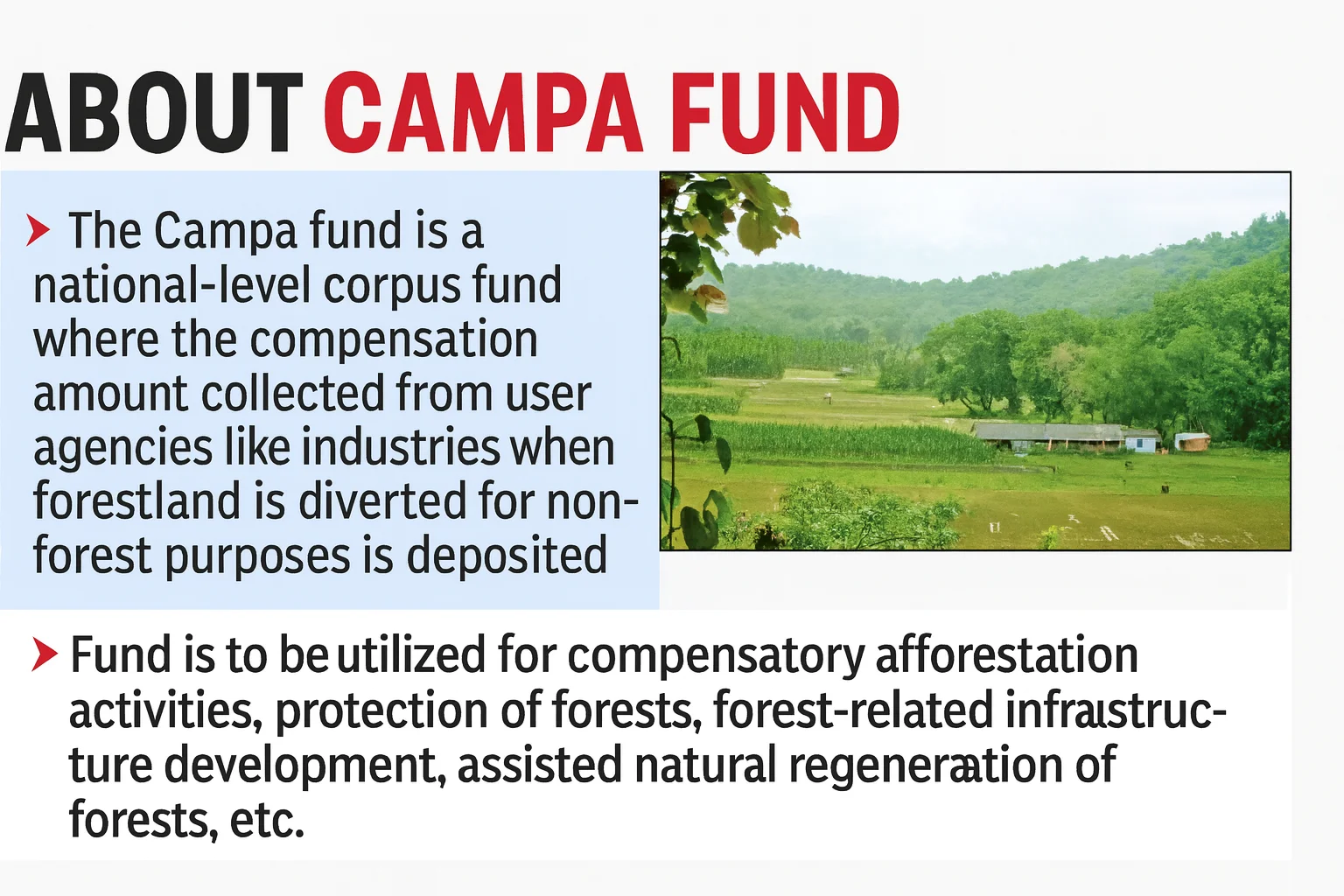Biodiversity & Environment
Central Empowered Committee Report on CAMPA
- 01 Aug 2025
- 8 min read
For Prelims: Compensatory Afforestation Fund Management and Planning Authority (CAMPA), Compensatory Afforestation Fund (CAF) Act, 2016, Forest (Conservation) Act, 1980, Ministry of Environment, Forest and Climate Change (MoEFCC), Comptroller and Auditor General of India
For Mains: CEC Report on CAMPA, About CAMPA, Challenges Related to its Implementations and Way Forward
Why in News?
The Supreme Court-mandated Central Empowered Committee (CEC) assessed India's compensatory afforestation initiatives, finding that while 85% of the target has been met, only 67.5% of the CAMPA funds have been utilized.
What is Compensatory Afforestation Fund Management and Planning Authority (CAMPA)?
- About: The CAMPA is a statutory body established (in both at centre and states/UTs) under Compensatory Afforestation Fund (CAF) Act, 2016.
- It aims to manage and oversee funds collected for compensatory afforestation when forest land is diverted for non-forest purposes.
- Background: The Supreme Court established CAMPA in 2002 through the T.N. Godavarman vs Union of India (1995) case to monitor and guide Compensatory Afforestation (CA).
- It was created as an ad-hoc National Advisory Council due to unutilized afforestation funds and inconsistent fund management by states.
- Forest (Conservation) Act, 1980: As per the Forest (Conservation) Act, 1980 when forest land is diverted for non-forest purposes, the user agency is required to:
- Provide an alternative non-forest land for afforestation.
- Bear all the costs associated with the afforestation process.
- In cases where suitable non-forest land is unavailable for afforestation, the user agency must undertake afforestation on twice the area of degraded forest land.
- CAF Act, 2016: The CAF Act, 2016 came into force in 2018 and CAF Rules, 2018 institutionalized the management of afforestation funds.
- Dedicated Funds Created: The National CAF (NCAF) is managed under the Public Account of India by National CAMPA (MoEFCC), and the State CAF (SCAF) is managed under the Public Accounts of States/UTs by State CAMPA Authorities. Both are interest-bearing and non-lapsable.
- Fund Management: 90% of the CAMPA funds are allocated to States/UTs for afforestation, while 10% is retained by the Centre for oversight and capacity-building. The funds accrue annual interest as determined by the Central Government.
- CAG annually audits both National and State CAMPA for financial accountability.
- Permissible Activities Under CAMPA Funds: CAMPA funds support afforestation (compensatory, additional, penal), catchment treatment, and natural regeneration.
- They also aid forest and wildlife management, human-wildlife conflict mitigation, village relocation from protected areas, and initiatives for capacity building, and infrastructure development for forest and wildlife protection.
What are the Key Challenges in Implementation of CAF Act, 2016?
- Land Availability Constraints: The CAF Act, 2016 mandates that afforestation land be adjacent and contiguous to the diverted forest for better management.
- However, suitable non-forest land is often unavailable, especially in smaller states and heavily forested regions like Chhattisgarh. The land provided is frequently unsuitable for plantations and unfit for other productive uses.
- Diversion & Underutilisation of Funds: CAMPA funds, especially those collected before 2016, remained largely underutilised until serious implementation began post the CAF Act.
- Diversion of funds to other schemes like the Green India Mission has diluted the focus on compensatory afforestation.
- Ecological Limitations & Monoculture: Monoculture plantations under CAMPA reduce biodiversity, face biotic pressure, disrupt ecological corridors, and cause edge effects (ecological disruptions at habitat boundaries), weakening overall ecosystem integrity.
- Greenwashing & Rights Violations: Experts warn of greenwashing, where compensatory afforestation replaces rich forests with commercial plantations, lacking ecosystem services.
- They also highlight how unilateral fund control by forest officials sidelines tribals and forest dwellers, violating Forest Rights Act, 2006.
- Policy & Institutional Gaps: Delays in plan submissions, fund release, and lack of dedicated CAMPA offices hinder implementation. The Parliamentary Committee flagged the CAF Act's bureaucratic nature and absence of timelines.
- The IPCC 2023 report warned that replacing natural forests with afforestation elsewhere leads to net ecological loss, weakening climate and biodiversity goals.
What Measures Can be Taken to Strengthen CAMPA?
- Ecologically Viable Land Bank: Create a central land bank of non-forest/degraded forest lands near existing forests to enhance ecological connectivity, reduce edge effects, improve survival rates, and resolve land availability issues.
- Fund Utilisation & Transparency: Ensure timely fund release, adhere to annual plans with clear timelines, strengthen audits, and mandate third-party monitoring and public disclosure.
- Biodiverse, Community-Led Approach: Shift from monocultures to native, multi-species plantations. Involve tribals and forest dwellers as per the Forest Rights Act, 2006 to enhance biodiversity, prevent greenwashing, and ensure socio-ecological justice.
- Legal & Policy Reforms: Amend the CAF Act to set time-bound afforestation targets, mandate ecological equivalence, and enforce penalties for violations.
- Link forest clearances to ecosystem service restoration, not just land area. Align CAMPA with IPCC guidelines, India’s NDCs, and the Paris Agreement to avoid net ecological loss.
- Link forest clearances to ecosystem service restoration, not just land area. Align CAMPA with IPCC guidelines, India’s NDCs, and the Paris Agreement to avoid net ecological loss.
|
Drishti Mains Question: What is the role of the Compensatory Afforestation Fund Management and Planning Authority (CAMPA) in India’s forest governance? Critically examine its effectiveness in achieving environmental and developmental balance. |
UPSC Civil Services Examination, Previous Year Question (PYQ)
Q. Consider the following statements: (2019)
- As per law, the Compensatory Afforestation Fund Management and Planning Authority exists at both National and State levels.
- People’s participation is mandatory in the compensatory afforestation programmes carried out under the Compensatory Afforestation Fund Act, 2016.
Which of the statements given above is/are correct?
(a) 1 only
(b) 2 only
(c) Both 1 and 2
(d) Neither 1 nor 2
Ans: (a)







